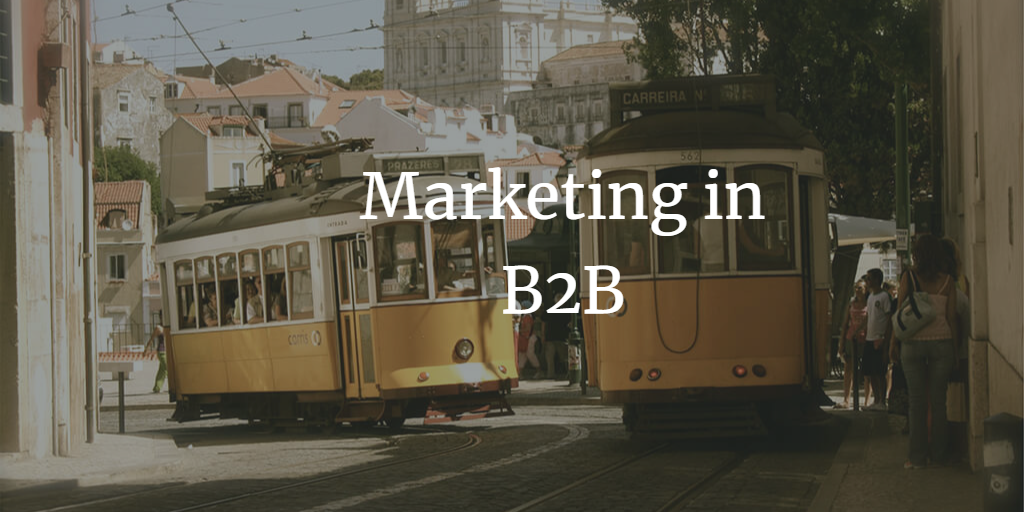Marketing in B2B: The War Between Science and Art

Table of Contents
Introduction
The Science of B2B Marketing
The Art of B2B Marketing
Balancing Science and Art in B2B Marketing
Success Stories: B2B Brands Getting It Right
Recommendations: How to Win the War Between Science and Art
Case Study: Apple's B2B Marketing
Why Is Balance Crucial?
Conclusion
Introduction
The world of marketing has often been seen as a battle ground, where the calculated, data-driven strategies of science clash against the creative, imaginative ideas of art. This view has given rise to a long-standing debate in the industry: Which is more crucial in shaping a successful marketing strategy, the science or the art?
This question is particularly pertinent in B2B (business-to-business) marketing, where the stakes are high, the sales cycles are long, and the target audience is typically a blend of rational decision-makers and emotive individuals.
Historically, marketing was viewed as a predominantly creative discipline—an art. The focus was on crafting compelling narratives, designing engaging visuals, and evoking emotions that drive consumer behavior. However, the advent of the digital age and the subsequent explosion of data have tilted the scales, highlighting the growing importance of scientific elements in marketing.
In the current data-driven era, marketers have access to an unprecedented amount of information about their audience. This data allows for a more methodical and analytical approach to marketing, thereby underscoring the role of science. Today, marketers can track metrics, analyze patterns, and use these insights to drive their strategies—a process that's more akin to a scientific experiment than an artistic endeavor.
But does this mean that the art of marketing is losing its relevance in the face of scientific methods? Or is there a way for these two disciplines to coexist in harmony, complementing and enriching each other to form an effective marketing strategy?
In this article, we'll delve into the fascinating war between science and art in B2B marketing. We'll explore the unique strengths and contributions of each discipline and discuss how they can be harmoniously integrated to shape powerful, impactful marketing strategies. By the end of this piece, you'll gain a new perspective on the intricate relationship between science and art in marketing, empowering you to navigate the B2B marketing landscape with a balanced, holistic approach.
The Science of B2B Marketing
The "science" in marketing refers to the data-driven, analytical side. With advancements in technology, marketers now have access to vast amounts of data, ranging from demographic information to detailed behavioral insights.
For example, tools like Google Analytics, HubSpot, or Salesforce provide insights into how customers interact with your brand across different channels. These tools allow you to segment your audience, track customer journeys, measure ROI, and more.
Data can also fuel predictive analytics, a powerful tool for forecasting future trends and behaviors. This can be particularly useful in B2B marketing, where sales cycles are often longer and more complex.
Data-Driven Decision Making
In today's digital age, data is a powerful tool that marketers can leverage. The use of data in making decisions allows marketers to quantify their strategies and assess performance in real-time.
Technological Innovations
Advancements in technology have brought forth a plethora of tools that facilitate marketing automation, personalization, analytics, and more. These tools have become a cornerstone in the scientific aspect of B2B marketing.
Digital Marketing Channels
The rise of digital marketing channels such as social media, email, SEO, and content marketing has given marketers the ability to track, measure, and analyze marketing activities in unprecedented ways.
The Art of B2B Marketing
While data provides the framework, the "art" in marketing brings this framework to life. It's about creating compelling narratives, evoking emotion, and building a memorable brand.
Creative elements like copywriting, design, and video production play a significant role here. They help convey your brand's personality, values, and unique selling propositions in a way that resonates with your audience.
Moreover, storytelling is a potent tool in the art of marketing. A good story can captivate your audience, simplify complex ideas, and evoke powerful emotions that drive action. For B2B marketers, storytelling can help humanize their brand, making it more relatable to customers.
Storytelling
The art of storytelling is a crucial aspect of B2B marketing. It allows brands to connect with their audiences on an emotional level and communicate their values and mission effectively.
Branding and Design
Branding and design play a vital role in creating a visual identity that sets a company apart. They are key to influencing perceptions and creating an impact in the mind of the consumer.
Emotional Engagement
In B2B marketing, fostering emotional engagement is an art form. It is about building relationships, nurturing leads, and creating a sense of community around your brand.
Balancing Science and Art in B2B Marketing
The harmonization of science and art in B2B marketing is the key to successful and robust strategies. However, finding the perfect balance is challenging, yet achievable. Here are some effective approaches you can take.
Identify Your Objectives: Begin by understanding what you aim to achieve from your marketing efforts. Are you looking to increase brand awareness, generate leads, or nurture existing customers? Your goals will dictate how you balance the creative and analytical aspects.
Know Your Audience: Use data to gain a deep understanding of your target audience. Dive into demographics, firmographics, behavior, and psychographics. The more you know your audience, the better you can craft messages that resonate on a deep, emotional level.
Leverage Technology: Utilize marketing technology tools to gather and analyze data, automate tasks, and measure performance. But, also remember that technology should support creativity, not replace it.
Embrace Testing: The balance between science and art will be different for every business, and even for different campaigns. Use A/B testing to find the right balance for your particular context.
Harmonizing Data and Creativity
Balancing the science and art of B2B marketing involves harmonizing data and creativity. Data offers insights into customer behavior and market trends, informing the creative process. Simultaneously, creativity makes data compelling and relatable, transforming raw figures into stories that inspire action.
Integrating Technology and Emotional Appeal
Integrating technology and emotional appeal is another facet of this balance. While technology offers tools to reach and interact with the audience, emotional appeal creates a meaningful connection that resonates on a personal level. Together, they allow marketers to communicate the right message to the right person at the right time.
Combining Analytical and Intuitive Approaches
Successful B2B marketers combine analytical and intuitive approaches. Analytical methods enable marketers to make data-backed decisions, while intuition often leads to innovative ideas and fresh perspectives. This blend results in strategies that are not only efficient but also unique and impactful.
Success Stories: B2B Brands Getting It Right
Several B2B companies have achieved notable success by skillfully blending the science and art of marketing:
1. IBM: IBM is a master at telling engaging stories. They use their technological prowess to collect and analyze data, then turn those insights into narratives that resonate with their customers. Their 'Smarter Planet' campaign is a prime example, which narrates how their technology is helping build a smarter, more efficient world.
2. Adobe: Adobe's marketing strategies deftly combine creativity and data. They use their analytics capabilities to understand their audience and then employ imaginative storytelling to create compelling campaigns. Their 'Make the Cut' campaign invited users to produce their version of a music video using Adobe's software, reflecting an understanding of their customers and a creative way to engage them.
3. Mailchimp: Mailchimp has effectively leveraged its brand personality to differentiate itself in a competitive market. Their quirky, fun, and distinctive branding is complemented by their utilization of data to deliver personalized experiences and services.
Recommendations: How to Win the War Between Science and Art
To successfully balance the science and art of B2B marketing, here are some recommendations:
1. Use Data to Inform Creativity
Rather than seeing data and creativity as opposing forces, use data to fuel creativity. Understand your audience’s behavior, preferences, and pain points using data, and then create compelling stories or campaigns that address these insights.
2. Personalize Your Messaging
Leverage technology to personalize your messaging. While creativity helps in crafting a compelling story, technology aids in delivering this story to the right person at the right time, significantly increasing its impact.
3. Understand Your Buyer's Journey
The buyer's journey in B2B marketing is often more complex than in B2C. Understand this journey using analytical tools, and then design your creative elements to effectively guide your buyers through this journey.
4. Foster a Culture of Innovation
Encourage an environment where new ideas are celebrated. A culture of innovation will help combine the science of analytical thinking with the art of creative solutions.
Case Study: Apple's B2B Marketing
A perfect example of a company that seamlessly blends science and art in its B2B marketing is Apple.
Apple is renowned for its cutting-edge technology, and this "science" aspect clearly comes across in its marketing. However, Apple also excels in the "art" of marketing, creating compelling narratives that touch human emotions.
From a data-driven perspective, Apple uses its understanding of consumer behavior and preferences to develop products that consumers desire. They gather insights about their audience and use them to steer their product development and marketing direction.
Creatively, Apple's marketing often tells a story. Their campaigns are full of compelling narratives that evoke emotion and spark inspiration. They don't just sell products; they sell dreams and visions of what could be.
Why Is Balance Crucial?
In today's hyper-competitive B2B landscape, standing out requires more than just a solid product or service - it requires a strong, distinctive brand. A successful B2B marketing strategy needs to appeal to both the rational and emotional sides of the buyer. This is where the blend of science and art becomes crucial.
Scientific aspects, like data analytics and predictive modeling, help in understanding market trends, customer behavior, and campaign effectiveness. On the other hand, the art of marketing - storytelling, design, and creative thinking - helps to evoke emotions and create memorable brand experiences.
Balancing both can be challenging but necessary. Over-reliance on data can lead to generic, uninspiring marketing, while excessive focus on creativity can result in beautiful but ineffective campaigns. The key lies in leveraging the strengths of both to create data-driven, yet emotionally engaging marketing campaigns.
Conclusion
In the B2B marketing world, science and art are far from mutually exclusive. In fact, the most effective marketing strategies are those that successfully integrate the two, resulting in a symbiotic relationship that maximizes the strengths of each discipline.
The science side of marketing gives us valuable insights into our audience's behaviors, preferences, and needs. It allows us to make informed decisions about our strategy, underpinning each action with reliable data. By understanding the science behind marketing, we can segment audiences, analyze campaign performance, optimize conversion funnels, and make predictions about future behavior.
On the other hand, the art side of marketing brings creativity, innovation, and human touch to the equation. It's the art that crafts compelling narratives, evokes emotion, and connects with the audience on a personal level. Artistic elements in marketing breathe life into data, transforming raw numbers into captivating stories and powerful messages.
In the realm of B2B marketing, where purchasing decisions are often more complex and involve a longer decision-making process, the blend of science and art is particularly crucial. By leveraging data (the science), we can understand the needs of our business clients. Meanwhile, by implementing creative strategies (the art), we can craft personalized experiences that resonate with multiple decision-makers in an organization.
As we venture into the future, the intersection of science and art in B2B marketing will only become more pronounced. Technologies like AI and machine learning will further enhance our ability to collect and analyze data, while advances in design and


